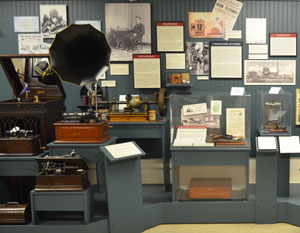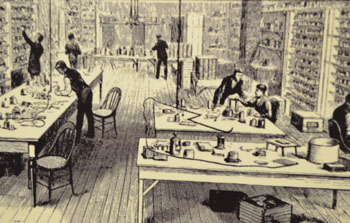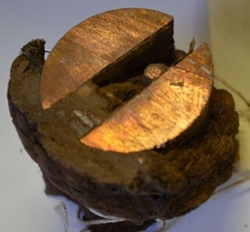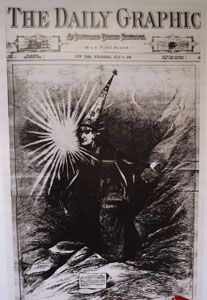Thomas Edison and the Role of Copper in His Inventions
 Thomas Edison Museum, Menlo Park, NJ.
Thomas Edison Museum, Menlo Park, NJ. Photograph by Paul David.
Born in Milan, Ohio, on February 11, 1847, Thomas Edison become one of the world's most notable visionaries, often using copper to bring his inventions to life.
As a child, Edison sold candy and newspapers on trains that ran from Port Huron to Detroit. When he rescued a three-year-old, Jimmie Mackenzie, from a runaway train, the boy's grateful father (a station agent) trained him as a telegraph operator. He became known as Tom, studied quantitative analysis, made improvements to the telegraphs and conducted chemical experiments on the train. Later, as a telegrapher and while improving a battery, he spilled sulfuric acid that leaked onto a desk belonging to his boss and was fired. But many of his developments were a direct outgrowth of his early telegraph experiences and the use of wiring that he perfected.
Although Edison did not invent the incandescent lamp, he improved it so it was commercially viable. He exhibited his lighting system at Christie Street, Menlo Park, on New Year's Eve in 1879 and gained permission to construct his first power station on Pearl Street in Manhattan, NY. He developed a process of electric power generation and distribution to homes, businesses and factories.
Edison began his career as an actual patented inventor at the age of 21 when living in Boston, where he created his Vote Counter. Some of his very important patented inventions were the Universal Stock Printer created in NYC and the Quadruplex Telegraph made in Newark, NJ. It was not until working in the sleepy town of Menlo Park, NJ, that he began the world's first organized research and development laboratory and became world-famous. He created a single facility where skilled engineers, glass-blowers, blacksmiths, machinists and other experimenters could research, develop, manufacture and collaborate on new technologies.
 Illustration depicting Edison's workshop at Menlo Park, NJ
Illustration depicting Edison's workshop at Menlo Park, NJKathleen Carlucci, director of The Thomas Edison Center at Menlo Park, verifies that he created more than 400 inventions during his six years (1876-1882) there. "He used copper in almost all his electrical inventions; inside phones, motors, generators and electromagnets. It was utilized in relays not wholly made of copper. There were vast amounts of copper in electromagnets for his generators. An original bipolar Edison generator/dynamo now on site contains very large coils of copper wire and demonstrates the principle of how a magnetic field is created when a magnet moves inside these coils. He experimented with copper wiring, for which he then had to develop insulation, and found that copper was an excellent conductor of electricity, much better than iron wires which were previously used. He even tried, unsuccessfully, to use copper in filament material."
Carlucci mentions the experimental electric train Edison built at Menlo Park, winding from the west side of the machine shop at the corner of Christie Street and Middlesex Avenue and running about three blocks north to a small copper mine called "Mine Gully." When he discovered copper ore deposits in the area, he sank a shaft for his very own copper mine. The effort seemed uneconomical and inefficient so the mine was abandoned. The electric railway became a success in 1881. One of his many patents was for developing the art of separating copper ore from other metals.
 The first electric transmission cable for New York City.
The first electric transmission cable for New York City. Photograph by Paul David.
Edison was an astute businessman. At one point, the company had orders totaling $200,000 worth of copper but lacked the payment. After a representative from Astonia Brass and Copper Company looked over the accounting books, the owner, Mr. Cowles, said, "I will let you have the copper." And, for years he trusted them with all the copper they wanted even if they didn't have the money to pay for it.
In 1877, Edison invented a carbon button microphone that made the telephone a more practical instrument. Then, with the invention of the phonograph in 1877, people flooded to Menlo Park to see the birthplace of recorded sound and where it could be played back. The New York Daily Graphic referred to Edison as "The Wizard of Menlo Park" and the name stuck.
The phenomenal growth of the copper industry at that time was due to the rapid and increasing demand because of the telephone, electric light, electric motor, most of his basic inventions. Edison recognized the necessity of pure quality copper for electrical conductors which compelled manufacturers to try new and additional methods of refinement. He practiced economizing these conductors and was able to reduce the cost of copper per lamp from $23.24 to $3.72.
 Edison was known as The Wizard of Menlo Park.
Edison was known as The Wizard of Menlo Park.Photograph by Paul David.
By the time of his death in 1931, he held 1,093 patents covering refinements of devices in telegraphy, telephony, electric power generation and lighting, sound recording, motion pictures, storage batteries, plus mining and cement technologies. Most were utility patents for inventions or processes of electrical, mechanical or chemical nature and included about a dozen design patents.
About the present day, Carlucci says, "The site had been divided up and was parceled back together by the Edison Pioneers, a group of men who had worked for Edison. After initiated, the group met and honored Edison every year on his birthday while he was alive. They also paid for the Edison Memorial Tower. It was dedicated in 1938 on what would have been his 91st birthday. The Art Deco shaft tapers upward to a monumental 14-foot replica of his first practical incandescent bulb, which must be the largest in the world. A building was constructed in approximately 1942 as a gatehouse for the Tower. It became a museum in the 1940s to honor Edison's memory and educate the public about his accomplishments and his impact on modern research and development. We are located in the Edison State Park and the Edison Memorial Tower is listed on the New Jersey and National Registers of Historic Places."
Visitors can view the museum on Thursdays, Fridays and Saturdays from 10:00 a.m. to 4:00 p.m. Docents discuss Menlo Park and the historic inventions created there. There are interpretive and informative displays tailored to each group or age. A renovation that took place three years ago resulted in updated, more professional exhibits. Special tours can also be set up for anyone interested in knowing more about Thomas Edison's work.
The 77-year-old Tower is undergoing restoration. The non-profit Thomas Edison Center will hold a rededication event Saturday, October 24th, 2015.
Resources:
Thomas Edison Center, 37 Christie Street, Edison, NJ, (732) 549-3299
Also in this Issue:
- Thomas Edison and the Role of Copper in His Inventions
- Deliziare’s Whimsical Wire Work
- Sio Metalworks: Modern Copper Works Inspired by the Arts and Crafts Movement
- Spiritiles: Depict the Art and Wisdom of Everyday Life
- Rodin: The Human Experience at Michener Museum
